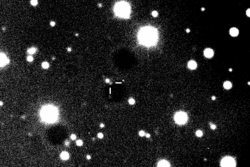Astronomy:Taygete (moon)
 Taygete imaged by the Canada-France-Hawaii Telescope in December 2001 | |
| Discovery [1] | |
|---|---|
| Discovered by | Scott S. Sheppard David C. Jewitt Yanga R. Fernandez Eugene A. Magnier |
| Discovery site | Mauna Kea Observatory |
| Discovery date | 25 November 2000 |
| Designations | |
Designation | Jupiter XX |
| Pronunciation | /teɪˈɪdʒətiː/[2][3] |
| Named after | Τᾱϋγέτη Tāÿgetē |
| S/2000 J 9 | |
| Adjectives | Taygetean /ˌteɪədʒəˈtiːən/[4] |
| Orbital characteristics [5] | |
| Epoch 23 March 2018 (JD 2458200.5) | |
| Observation arc | 17.46 yr (6,377 days) |
| 0.1507123 astronomical unit|AU (22,546,240 km) | |
| Eccentricity | 0.2487538 |
| Orbital period | –691.62 d |
| Mean anomaly | 150.90619° |
| Mean motion | 0° 31m 13.862s / day |
| Inclination | 165.95236° (to ecliptic) |
| Longitude of ascending node | 14.91608° |
| 283.34358° | |
| Satellite of | Jupiter |
| Group | Carme group |
| Physical characteristics[7] | |
| Mean diameter | 5 km |
| Albedo | 0.04 (assumed) |
| Apparent magnitude | 21.9[6] |
| Absolute magnitude (H) | 15.5[5] |
Taygete /teɪˈɪdʒətiː/, also known as Jupiter XX, is a retrograde irregular satellite of Jupiter. It was discovered by a team of astronomers from the University of Hawaii led by Scott S. Sheppard, in 2000, and given the temporary designation S/2000 J 9.[8][1][9]
Taygete is about 5 kilometres in diameter, and orbits Jupiter at an average distance of 22,439,000 km in 691.62 days, at an inclination of 165° to the ecliptic (163° to Jupiter's equator), in a retrograde direction and with an eccentricity of 0.3678.
It was named in October 2002[10] after Taygete, one of the Pleiades, daughter of the Titan Atlas and mother of Lacedaemon by Zeus (Jupiter).
It belongs to the Carme group, made up of irregular retrograde moons orbiting Jupiter at a distance ranging between 23 and 24 Gm and at an inclination of about 165°. Like Carme but unlike Kalyke, it is light red in color (B−V=0.56, V−R=0.52).[11]
References
- ↑ 1.0 1.1 MPEC 2001-A29: S/2000 J 7, S/2000 J 8, S/2000 J 9, S/2000 J 10, S/2000 J 11 2001 January 15 (discovery and ephemeris)
- ↑ Noah Webster (1884) A Practical Dictionary of the English Language
- ↑ "Taygete". Dictionary.com Unabridged. Random House. https://www.dictionary.com/browse/Taygete.
- ↑ There is also 'Taygetian', but that's for Taygetus.
- ↑ 5.0 5.1 "M.P.C. 110499". Minor Planet Circular. Minor Planet Center. 29 May 2018. https://minorplanetcenter.net/iau/ECS/MPCArchive/2018/MPC_20180529.pdf.
- ↑ Sheppard, Scott. "Scott S. Sheppard - Jupiter Moons". Department of Terrestrial Magnetism. Carnegie Institution for Science. https://sites.google.com/carnegiescience.edu/sheppard/moons/jupitermoons. Retrieved 26 November 2020.
- ↑ "Planetary Satellite Physical Parameters". Jet Propulsion Laboratory. 19 February 2015. https://ssd.jpl.nasa.gov/?sat_phys_par#jupiter. Retrieved 26 November 2020.
- ↑ IAUC 7555: Satellites of Jupiter 2001 January 5 (discovery)
- ↑ MPEC 2001-T59: S/2000 J 8, S/2000 J 9, S/2000 J 10 2001 October 15 (revised ephemeris)
- ↑ IAUC 7998: Satellites of Jupiter 2002 October 22 (naming the moon)
- ↑ Grav, Tommy; Holman, M. J.; Gladman, B. J.; Aksnes, K. (2003). "Photometric survey of the irregular satellites". Icarus 166 (1): 33–45. doi:10.1016/j.icarus.2003.07.005. Bibcode: 2003Icar..166...33G.
 |

